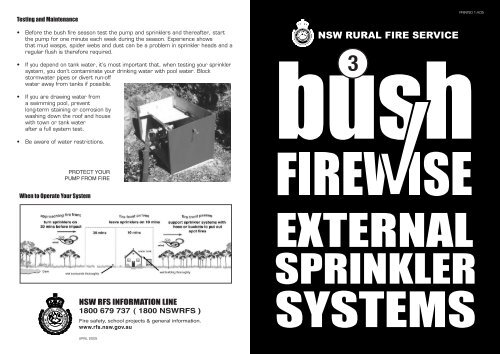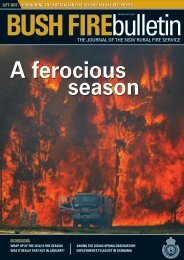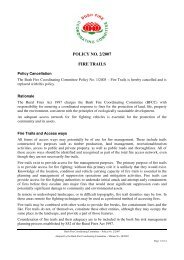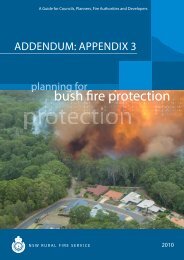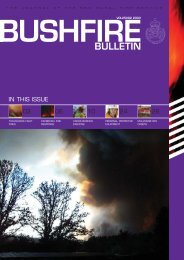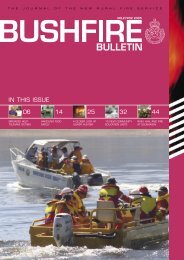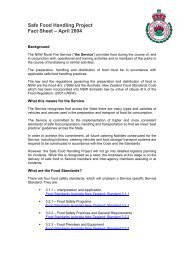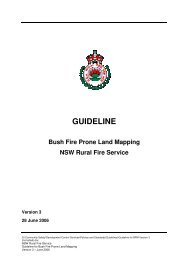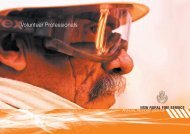system - NSW Rural Fire Service
system - NSW Rural Fire Service
system - NSW Rural Fire Service
Create successful ePaper yourself
Turn your PDF publications into a flip-book with our unique Google optimized e-Paper software.
Testing and Maintenance<br />
PRINTED 1.4.05<br />
• Before the bush fire season test the pump and sprinklers and thereafter, start<br />
the pump for one minute each week during the season. Experience shows<br />
that mud wasps, spider webs and dust can be a problem in sprinkler heads and a<br />
regular flush is therefore required.<br />
• If you depend on tank water, it’s most important that, when testing your sprinkler<br />
<strong>system</strong>, you don’t contaminate your drinking water with pool water. Block<br />
stormwater pipes or divert run-off<br />
water away from tanks if possible.<br />
• If you are drawing water from<br />
a swimming pool, prevent<br />
long-term staining or corrosion by<br />
washing down the roof and house<br />
with town or tank water<br />
after a full <strong>system</strong> test.<br />
• Be aware of water restrictions.<br />
<strong>NSW</strong> RURAL FIRE SERVICE<br />
bush<br />
3<br />
PROTECT YOUR<br />
PUMP FROM FIRE<br />
When to Operate Your System<br />
EXTERNAL<br />
SPRINKLER<br />
<strong>NSW</strong> RFS INFORMATION LINE<br />
1800 679 737 ( 1800 <strong>NSW</strong>RFS )<br />
<strong>Fire</strong> safety, school projects & general information.<br />
www.rfs.nsw.gov.au<br />
SYSTEMS<br />
APRIL 2005
If you are building a new house or doing major extensions you will be required to meet<br />
the standards in “Planning for Bushfire Protection”. By following these conditions your<br />
house will comply with the safety standards and possibly will not need an external<br />
water sprinkler <strong>system</strong> (EWSS). If, however, you have an existing house, and you live<br />
in a fire-prone area, this pamphlet provides guidance on installing a <strong>system</strong> to enhance<br />
your fire safety.<br />
SPRINKLER SYSTEMS<br />
* A sprinkler <strong>system</strong> alone will not provide adequate fire safety measures for your<br />
home but can greatly enhance your survivability if all other property preparations have<br />
been done.<br />
Sprinkler <strong>system</strong>s, also known as external water spray <strong>system</strong>s, will add considerable<br />
protection to a well-prepared property.<br />
A sprinkler <strong>system</strong> is used to cover the property with water and, at the same time,<br />
can be designed to be utilised as a firefighting resource. Apart from sprinkler heads,<br />
hose outlets can be incorporated into the <strong>system</strong> (if there is enough pump capacity).<br />
Hoses can then be attached and used to put out spot fires.<br />
If there is a bush fire in your area and your property is well prepared it is important<br />
that you stay at home to start the sprinkler <strong>system</strong> and help firefighters protect your<br />
property. While computerised sprinkler <strong>system</strong>s are available, <strong>system</strong>s should rely on<br />
manual operation. If you are considering a computerised sprinkler <strong>system</strong> you need to<br />
be aware that the power could fail during a bush fire and render the <strong>system</strong> useless.<br />
Systems should not utilise reticulated mains <strong>system</strong>s as these are usually being used<br />
by firefighters who can draw large amounts of water, limiting your <strong>system</strong> or making<br />
it unusable.<br />
* Check your local council to determine if approvals are necessary to install a <strong>system</strong><br />
EFFECTIVE SPRINKLER SYSTEMS SHOULD MEET THE FOLLOWING CRITERIA:<br />
Independent Water Supply<br />
• As mains water pressure is likely to be reduced and unreliable during bush fires,<br />
connect the sprinkler <strong>system</strong> to an independent water supply.<br />
• The independent water supply could be a swimming pool, rainwater tank or dam<br />
and should be at least 22,000 litres. This is sufficient to run a sprinkler <strong>system</strong><br />
for a single dwelling for one hour or more depending on the number and types of<br />
sprinkler heads used. The capability can be extended if water is recirculated from<br />
the roof to a tank or back to the pool, dam etc.<br />
Pump<br />
• If your water supply is 25 metres or more above the sprinklers, gravity can get<br />
water around your <strong>system</strong>; if not, your <strong>system</strong> will need a petrol or diesel<br />
powered pump.<br />
• As power is likely to be lost during bush fires, do not use an electric pump<br />
(unless you have backup power such as a generator).<br />
• Locate the pump as close as possible to the water supply. Avoid placing the<br />
pump below the water level as an airlock can develop in the suction hose.<br />
The sprinkler head should be located so its<br />
spray overlaps the next adjoining sprinkler.<br />
directed onto windows<br />
Can allow water to recirculate to tank<br />
plug down pipes<br />
sprinkler head<br />
Capable of 90° to 360°<br />
Sprinkler heads should be located to thoroughly<br />
wet the roof, walls, windows<br />
Metal butterfly sprinklers<br />
Metal and impact the surrounding sprinklersarea.<br />
• Use the correct size, flame-resistant, suction hose with end strainer.<br />
• Keep the pump out of the weather and protected from fire.<br />
• Your local pump/irrigation shop will advise you on the right pump for your needs.<br />
• Ensure that the fuel capacity will allow the pump to run for at least one hour.<br />
Sprinkler Heads<br />
• There are several types of sprinkler heads that are suitable for use. The sprinkler<br />
head should provide for total saturation.<br />
• Head selection will depend on several factors including wind speed and direction.<br />
• Water droplet size is important, as a fine mist can be blown away from the<br />
structure to be protected.<br />
• There is no Australian standard for sprinkler <strong>system</strong>s.<br />
• There are several commercial companies who have designed sprinkler <strong>system</strong>s<br />
using a variety of sprinkler heads.<br />
• Have a look at as many sprinkler <strong>system</strong>s as you can before determining which is<br />
best for your application.<br />
• When fitting a DIY <strong>system</strong> talk to irrigation supply outlets and other businesses<br />
for advice.<br />
Pipes<br />
• Metal pipes are recommended.<br />
• The pipe from the pump to the house should be at least 300mm below ground<br />
level. 50mm diameter polyethylene (‘poly’) pipe may be used. Use 50mm metric<br />
compression fittings for pipe and pump connections.<br />
• Due to the radiant heat all above ground piping should be copper or galvanised<br />
steel.<br />
• Copper is easier to work with than galvanised steel. Copper pipe joints can be<br />
made with compression fittings or silver-soldered joints. Be aware that ‘soft<br />
solder’ could fail in a fire due to its low melting point.<br />
• To maintain water volume and pressure to all sprinkler heads the pipework should<br />
gradually decrease in diameter further from the pump.<br />
• Consider fitting ball valves in order to redirect the water flow where it is needed<br />
at any one time. Using ball valves can also give you outlet points at which you can<br />
connect a hose to fight spot fires.


